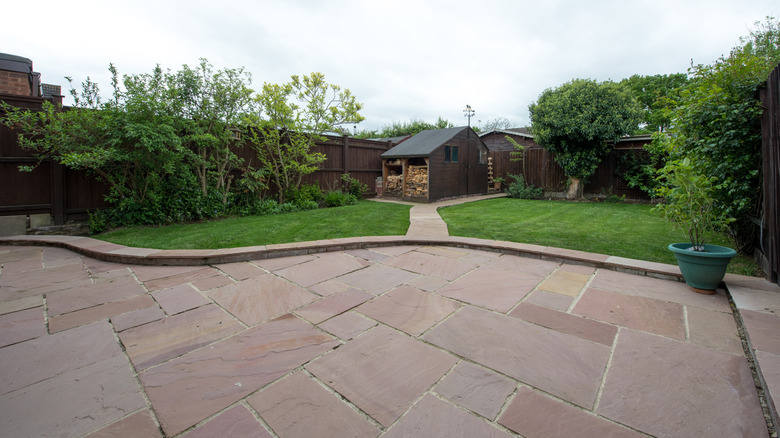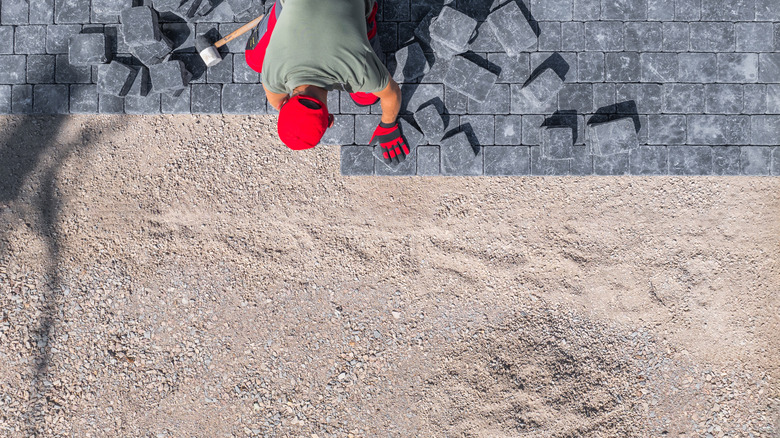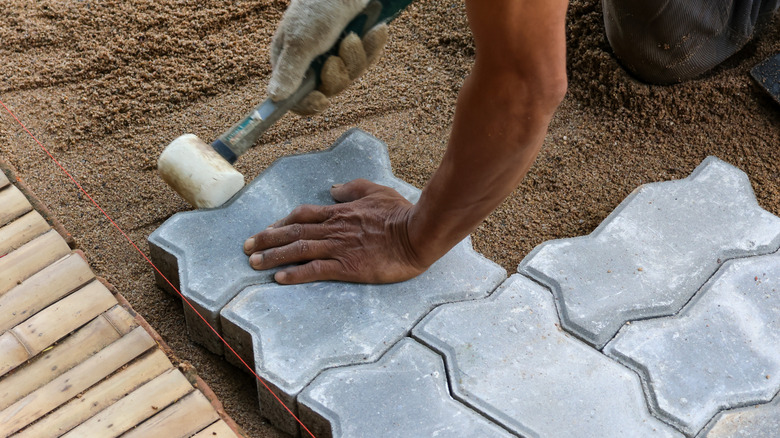How To Layout A Paver Plan When Designing Your Dream Patio
We may receive a commission on purchases made from links.
Did you know that pavers are the ultimate strength and durability champs — and are way stronger than concrete? Consider that the PSI of poured concrete is between 2,500 and 3,000 while that of pavers is 8,000 at the minimum. No wonder most pavers have a lifetime warranty.
Yet, strength is just one aspect. Pavers breathe. So, while they will heave a bit in the winter freezes, they often settle back perfectly after the ground thaws and dries out. If a patch is out of shape, you can simply remove the few blocks, do some rescreeding, and lay them back neatly again. What's more, pavers look nice, meaning they can enhance your curb appeal and improve the value of your home.
However, despite all these benefits, we've also got some bad news for you. If you don't lay out your pavers correctly, you'll throw all these advantages down the drain.
Fortunately, although not as DIY-able as trimming a hedge fence, installing pavers is still fairly easy. You first build up a proper foundation (emphasis on "proper"), then lay the pavers carefully, starting at a hard edge (think of a wall), before installing paver edging and adding jointing sand.
Of course, you can also add creative finishing touches, like installing outdoor lighting or container plants to bring nature closer to your space. Now that you can visualize this, let's go into the details.
How to lay out a proper foundation for pavers
First, ensure you have all the tools ready, including a shovel, a sturdy garden rake, and a hand tamper (True Temper's 8x8-inch tamper, a fantastic tool for compacting soil, sells on Amazon for around $60). You'll also need a rubber mallet, a tape measure, levels, a rafter square, a circular saw (and blades), and a wheelbarrow. And, of course, you shouldn't miss some safety gear, like a dust mask and goggles.
The first step is to mark out the square area you intend to work on by putting some pegs and strings for demarcation. Keep in mind that the marked-out area should have a gradient so water can run off the pavers and not pool, thereby creating slip hazards and breeding mold and mildew. To ensure the demarcated area is level, attach a line level to the strings. For the slope, aim for a 1-inch drop every 4 feet.
Now, excavate the marked-out area, ensuring the depth covers 4 to 6 inches for the base, an inch for the sand bedding, and typically 2 and ⅜ of an inch for the paver's thickness. Also, extend your excavation by 6 inches so you have room for paver edging.
The next step is to lay the cables, but only if you'll be installing landscape lighting. Now, use the hand tamper to compact the substrate. Alternatively, rent a plate compactor. When adding gravel, remember to do it in stages while compacting until you reach the desired 4- to 6-inch depth.
How to lay the pavers when designing your dream patio
Before laying the pavers, a 1-inch layer of sand should come first. For precision, place two polyvinyl chloride (PVC) pipes — with 1-inch outside diameter — above the gravel base and across the area you've been working on. This done, pour your paver sand. You can work with a 2-by-4 to level the sand.
You should then remove the 1-inch-diameter pipes and fill the gaps they've left with more sand. Now, lay the pavers. As we mentioned, start at a hard edge and proceed to the center, leaving a tiny gap between the blocks. Once in a while, you'll need to tap a few blocks down with a rubber mallet to ensure they sit flush with their counterparts. Here's where a straightedge can come in handy.
To ensure the blocks won't move, install paver edging along the perimeter and place spikes after every foot.
The final part is to add polymeric sand to fill the spaces between the blocks. Unlike other types of sand, polymeric sand forms tight bonds that can resist erosion, meaning no dealing with washed-away sand after a heavy downpour. However, you should ensure the pavers are dry before adding polymeric sand. Afterward, use something like a hand tamper to compact the sand.
You're not done yet. What remains is to remove any excess sand, mainly because excess sand often hardens and creates a permanent haze, messing up the look and evenness of your pavers. After this, spray your patio lightly with a hose, then give it 24 hours to cure.


